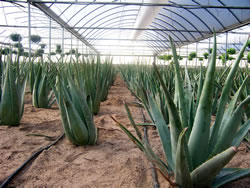Aloe Vera History
by Bill Wolfe, DDS

Aloe vera plants for Dr. Wolfe’s products are organically grown in climate controlled greenhouses.
In 1980 my dental laboratory technician suggested that Aloe Vera gel might have some uses in dentistry. I was not even sure what Aloe Vera was, so I decided to do some personal research. Through my readings, I discovered that the Aloe Vera plant had many medicinal uses dating back to pre-Christian times, and was even referred to in the Bible, as well as in many technical and professional journals over the past few decades.
I learned that the Aloe Vera plant is remarkable because it is one of the most durable plants known to mankind. The plant has a miraculous ability to self-seal, and contains all the nutrients within its leaf in order to survive. When the leaf is damaged, the plant seals the wound and regenerates in accelerated time. Also, it thrives in an arid environment and can withstand extreme heat and physical abuse. Ancient Hebrew tribes used to uproot their aloe plants when they migrated, replant them upon arriving at their destination, and the plants would flourish again. With such a prestigious history, I wondered why I had not heard about Aloe Vera before. There are basically two reasons why the use of Aloe Vera for medicinal purposes was not widespread.
Although the plant is one of the most durable plants in the world, it is a succulent, and cannot survive extreme cold, damp, freezing climates. Therefore, knowledge of Aloe Vera did not spread into Northern Europe or Great Britain, where there are profound freezing winters. In these areas of the world, familiarity with the plant and its uses is still limited.
The second reason tor its limited usage was due to the inadequacy of Aloe Vera gel as a commercially viable product, because of it’s “perishability.” When a leaf is harvested, it is dissected to gain access to its gel. Exposure to air causes Aloe Vera to oxidize, and its potency is only maintained for about 48 hours at room temperature. Beyond this time, the plant can become contaminated, which often led to disappointing results on the part of people who were unaware of the shelf-life problem of the gel.
A resurgence of interest in the healing capabilities of the Aloe Vera plant developed in the 1950’s. Through the work of Drs. Collins, Wright, and Crewe with radiation burns, the Aloe Vera plant assumed a degree of medical credibility. In 1959 the FDA concluded from studies conducted by the Atomic Energy Commission at the radiation burn center at Los Alamos Laboratories in New Mexico that aloe gel did have a healing effect on skin tissue. Further studies demonstrated the effectiveness of the plant’s gel, but perishability was still a problem.
I was particularly interested in studies from Russia in 1976 reporting success in treating periodontal (gum and bone) disease with Aloe Vera, and the 1979 studies performed at the University of Chicago Burn Center. Then I ran across the name of Dr. Eugene Zimmerman. Dr. Zimmerman had been my oral pathology professor at Baylor College of Dentistry, and unknown to me, was conducting research on Aloe Vera and its properties at the same time I was attending dental school there in 1969.
I telephoned Dr. Zimmerman and asked him about his past Aloe Vera research. He expressed his positive feelings about the healing potential of the plant’s gel for dentistry, especially since a “stabilization” process had been developed to preserve the Aloe Vera gel. The gel was now a viable commercial entity, with the ability to maintain its potency for years. However, Dr. Zimmerman felt that more research was required in order to substantiate its dental uses. I was now really curious.
After using the gel on various conditions with my dental patients, I phoned Dr. Zimmerman once again to tell him of our experiences, and asked him if he would be willing to perform any further dental research with the gel. His positive answer gave me the motivation and commitment to fund a grant to Baylor College of Dentistry to further investigate Aloe Vera and its oral health benefits.
The following presentation is a synopsis of the results of research performed at Baylor (to A.O.A.C. standards) under the guidance or Dr. Zimmerman.